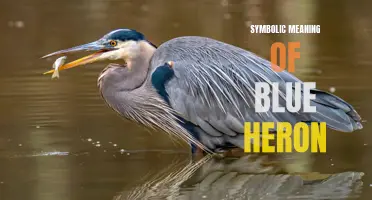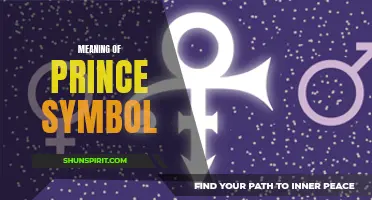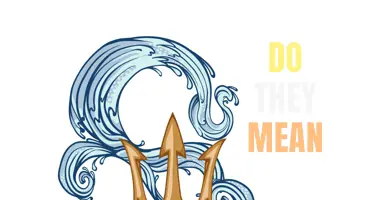
Vietnamese culture is rich in symbolism, with various symbols and their meanings deeply rooted in the country's history and traditions. From the iconic Vietnamese Ao Dai to the symbolic lotus flower, these symbols often represent the values, beliefs, and aspirations of the Vietnamese people. Whether it be dragon motifs on temples, the traditional conical hat called Non La, or the mythical turtle representing longevity and wisdom, each symbol carries a story and significance that adds to the cultural fabric of Vietnam. Exploring these symbols offers a fascinating glimpse into the beauty and depth of Vietnamese heritage, inviting us to appreciate the intricate meanings behind each emblematic representation.
What You'll Learn
- What are some of the most well-known symbols in Vietnamese culture and what do they represent?
- How have these symbols been incorporated into Vietnamese art and architecture?
- Are there any symbols in Vietnamese folklore that are still widely recognized today?
- How do Vietnamese symbols and meanings differ from those in other Southeast Asian cultures?
- Are there any symbols in Vietnamese culture that hold different meanings in different contexts or regions?

What are some of the most well-known symbols in Vietnamese culture and what do they represent?
Vietnamese culture is known for its rich and diverse symbolism, which is ingrained in various aspects of daily life. These symbols hold deep cultural meanings and offer insights into the values, beliefs, and traditions of the Vietnamese people. Here are some of the most well-known symbols in Vietnamese culture and what they represent:
- Ao Dai: The Ao Dai is the traditional Vietnamese dress for women. It is a long tunic, usually with a high collar and long sleeves, worn over wide-legged pants. The Ao Dai represents the grace, elegance, and modesty of Vietnamese women.
- Dragon: The dragon is a powerful symbol in Vietnamese culture, representing strength, prosperity, and good luck. It is often depicted in traditional art, architecture, and folklore. Dragons are believed to bring rain and protect the country from evil spirits.
- Lotus: The lotus flower is highly revered in Vietnamese culture for its beauty and purity. It symbolizes purity of the mind and spiritual enlightenment, as it grows from muddy waters but emerges pristine and untouched. The lotus is also associated with Buddhism and is a common motif in Vietnamese art and architecture.
- Turtle: The turtle is a sacred animal in Vietnam and is associated with longevity, wisdom, and good fortune. It is believed to be the connection between heaven and earth, as well as a guardian of the country. The turtle is often depicted in temples and pagodas and is considered a symbol of national strength and unity.
- Bamboo: Bamboo is a widely recognized symbol of Vietnamese resilience and adaptability. It represents strength, flexibility, and durability. Bamboo is used in various aspects of Vietnamese life, from construction and furniture to musical instruments and crafts. It is also seen as a symbol of simplicity and humility.
- Lion/Dog: The lion or lion-like dog, known as "shi" in Vietnamese, is a popular symbol of protection and warding off evil spirits. These mythical creatures are often seen guarding the entrances of temples, pagodas, and homes. They are believed to bring good luck and ward off negative energy.
- Vietnamese Flag: The Vietnamese flag is a significant national symbol, representing the people's struggle for independence and freedom. It features a red background with a large yellow star in the center. The red symbolizes the bloodshed and sacrifices made by the Vietnamese people, while the yellow star represents the unity and determination of the nation.
These symbols play a vital role in Vietnamese culture, connecting past traditions with the present and shaping the country's identity. They reflect the values of Vietnamese people, such as resilience, spirituality, and respect for nature. By understanding and appreciating these symbols, one can gain a deeper insight into the vibrant culture and heritage of Vietnam.
The Symbolic Meaning of Bird Poop on Your Car: What Does it Signify?
You may want to see also

How have these symbols been incorporated into Vietnamese art and architecture?
Vietnam, a country steeped in history and rich with cultural traditions, has a long-standing tradition of incorporating symbols into its art and architecture. These symbols not only serve to enhance the aesthetic appeal of the structures but also hold deep cultural and spiritual meanings for the Vietnamese people. In this article, we will explore some of the ways in which symbols have been incorporated into Vietnamese art and architecture.
One of the most prevalent symbols in Vietnamese art and architecture is the lotus flower. The lotus holds significant symbolic meaning in Vietnamese culture, representing purity, enlightenment, and spiritual growth. The flower is often depicted in various art forms, such as paintings, sculptures, and carvings. In architecture, lotus motifs can be found on pagodas and temples, where they are used to adorn the roofs and decorative elements of the buildings.
Another important symbol in Vietnamese art and architecture is the dragon. In Vietnamese culture, dragons are revered creatures associated with power, prosperity, and good luck. Dragon motifs can be seen in various art forms, including ceramics, lacquerware, and woodwork. In architecture, dragon sculptures are often found guarding the entrances of temples and pagodas, symbolizing protection and strength.
The yin and yang symbol, representing the balance between opposing forces, is also commonly incorporated into Vietnamese art and architecture. This symbol can be found in various forms, such as paintings, carvings, and designs on decorative objects. In architecture, the yin and yang symbol is often seen on the roofs and gates of buildings, symbolizing harmony and balance.
Vietnamese art and architecture also incorporate symbolism through colors. For example, red is often used to symbolize luck, happiness, and celebration. This color can be seen in various decorative elements, such as traditional costumes, paintings, and lacquerware. Yellow is another important color in Vietnamese culture, symbolizing royalty and prosperity. It is often used in the decoration of palaces, temples, and pagodas.
In conclusion, symbols play a significant role in Vietnamese art and architecture, adding depth and meaning to the structures and art forms. From the lotus flower representing purity to the dragon symbolizing power and prosperity, these symbols are deeply ingrained in Vietnamese culture. Whether it be the intricate carvings on a temple or the vibrant colors of a painting, they serve as a reminder of the rich cultural heritage of Vietnam.
Decoding the Hidden Symbolic Meaning of the Hotwife Lifestyle
You may want to see also

Are there any symbols in Vietnamese folklore that are still widely recognized today?
Vietnamese folklore is rich with colorful characters and stories that have been passed down through generations. While many of these characters may not be widely recognized today, there are a few symbols from Vietnamese folklore that still hold significance and are recognizable to the Vietnamese people.
One such symbol is the dragon, known as "Rong" in Vietnamese. The dragon is a powerful creature that is deeply ingrained in Vietnamese culture and is often seen as a symbol of strength, power, and good luck. Dragons are often depicted in art, architecture, and even on clothing and accessories. The dragon is also closely associated with water and is believed to bring rain, which is essential for agriculture in Vietnam.
Another symbol that is still recognized today is the phoenix, known as "Phuong Hoang" in Vietnamese. The phoenix is a mythical bird that is associated with rebirth and immortality. It is often depicted as a colorful bird with vibrant feathers that symbolize beauty and grace. The phoenix is considered a positive symbol in Vietnamese culture and is often associated with the sun and the heavens.
In addition to these mythical creatures, there are also folklore characters that are still recognized today. One such character is the "Truyen Kieu" or "The Tale of Kieu," which is a famous Vietnamese epic poem written by Nguyen Du in the 19th century. The main character, Kieu, is a talented and intelligent young woman who faces numerous challenges and sacrifices in her quest for true love. The story of Kieu is considered a masterpiece of Vietnamese literature and continues to be studied and celebrated to this day.
Another well-known character is the "Trong Dong" or "Bronze Drum," which is a symbol of Vietnamese cultural identity. Bronze drums have been used by various ethnic groups in Vietnam for thousands of years and are often associated with communal gatherings and important rituals. The sound of the bronze drum is believed to ward off evil spirits and bring good luck and prosperity.
While many symbols from Vietnamese folklore may not be widely recognized outside of Vietnam, they continue to play an important role in Vietnamese culture and identity. These symbols serve as a reminder of the rich history and traditions of the Vietnamese people and are a source of pride and inspiration for many.
The Symbolic Death Meaning: Understanding the Deeper Significance Behind the Final Transition
You may want to see also

How do Vietnamese symbols and meanings differ from those in other Southeast Asian cultures?
Vietnamese symbols and meanings have their unique characteristics that set them apart from other Southeast Asian cultures. While many symbols and their associated meanings might be similar across different cultures in the region, there are specific symbols and meanings that are distinct to Vietnam.
One of the most prominent symbols in Vietnamese culture is the lotus flower. The lotus holds great significance in Vietnam, as it represents purity, enlightenment, and the ability to rise above adversities. The lotus is often depicted in various forms of art, architecture, and religious ceremonies. It is also a symbol of Buddhism, which plays a significant role in Vietnamese culture.
Another important symbol in Vietnamese culture is the dragon. Unlike in other Southeast Asian cultures, where the dragon is often associated with power and strength, the dragon in Vietnamese culture is a symbol of wisdom, nobility, and good fortune. Dragons are featured in a wide range of Vietnamese art and architecture, including dragon-shaped roofs, dragon boat races, and dragon dance performances during festivals.
The yin and yang symbol, commonly known as "taijitu," is also an important symbol in Vietnamese culture. It represents the concept of balance and harmony between opposing forces. In Vietnam, the yin and yang symbol is often associated with traditional medicine and the belief in maintaining a balanced lifestyle.
While these symbols hold significant meanings in Vietnamese culture, it is important to note that symbols can vary in different contexts and interpretations. The meaning of a symbol can also be influenced by personal beliefs and experiences.
In comparison to other Southeast Asian cultures, Vietnamese symbols and meanings may have some similarities but also distinct differences. For example, the lotus flower is also prominent in Thai and Cambodian cultures, representing purity and enlightenment. However, the dragon symbol in Vietnamese culture differs from other Southeast Asian cultures, where it is often associated with power and protection.
It is also worth mentioning that Vietnamese culture has been influenced by its tumultuous history, including periods of Chinese and French occupation. These influences have shaped and added layers of complexity to the symbols and meanings present in Vietnamese culture.
In conclusion, Vietnamese symbols and meanings possess their unique characteristics that distinguish them from other Southeast Asian cultures. The lotus flower, dragon, and yin and yang symbol hold significant meanings in Vietnamese culture, each representing different aspects of life, spirituality, and balance. While there might be similarities among symbols shared across Southeast Asian cultures, the distinct interpretations and contexts in Vietnam make their symbols and meanings truly unique.
Understanding the Symbols on a Verona Oven: A Guide to Unraveling their Meaning
You may want to see also

Are there any symbols in Vietnamese culture that hold different meanings in different contexts or regions?
Symbols are an important part of any culture, and Vietnamese culture is no exception. They can hold different meanings depending on the context and region they are used in. In this article, we will explore some symbols in Vietnamese culture that have different interpretations based on their context and the region they are used in.
One such symbol is the lotus flower. The lotus flower is a widely recognized symbol of purity and enlightenment in Vietnamese culture. It is often associated with Buddhism and is often used in Buddhist iconography. However, in some regions of Vietnam, the lotus flower also carries a romantic connotation. It is seen as a symbol of love and beauty in these areas, and is often used in wedding ceremonies and decorations.
Another symbol that holds different meanings in different contexts is the dragon. In Vietnamese culture, the dragon is a symbol of power, strength, and good fortune. It is often used in art, architecture, and even on the national flag. However, in some regions, particularly in the northern part of Vietnam, the dragon is also associated with water and the agricultural fertility it brings. It is seen as a symbol of rain and good harvest, and is often depicted along with clouds and lightning in these regions.
The buffalo is another symbol that holds different meanings across different contexts and regions in Vietnam. In general, the buffalo is seen as a symbol of strength, hard work, and prosperity. It is often used in folk art and is an important part of rural life in Vietnam. However, in some regions, particularly in the Mekong Delta, the buffalo is also associated with water and fertility. It is seen as a symbol of abundance and is often depicted in fields or alongside rivers.
The yin and yang symbol is another symbol that holds different meanings in different contexts. In Vietnamese culture, the yin and yang symbol represents the balance and harmony between opposites. It is often used in traditional medicine and martial arts. However, in some regions, particularly in the central part of Vietnam, the yin and yang symbol also represents the balance between heaven and earth. It is seen as a symbol of spiritual harmony and is often used in religious rituals and ceremonies.
In conclusion, symbols in Vietnamese culture can hold different meanings depending on the context and region they are used in. The lotus flower, dragon, buffalo, and yin and yang symbol are just a few examples of symbols that have different interpretations based on their context and the region they are used in. These symbols play an important role in Vietnamese culture and add depth and richness to its traditions and customs.
Decoding the Meaning Behind Mickey's Beer Cap Symbols
You may want to see also
Frequently asked questions
Answer: The Vietnamese flag, also known as the "red flag with a yellow star," has a deep symbolic meaning. The red color represents the revolution and the bloodshed that was sacrificed for independence and freedom. The yellow star represents the unity and strength of the Vietnamese people in their fight for liberation.
Question: What is the significance of the lotus flower in Vietnamese culture?
Answer: The lotus flower holds great significance in Vietnamese culture and is often seen as a symbol of purity, enlightenment, and resilience. It is often associated with Buddhism and is considered a sacred flower. The lotus flower also represents the ability to rise above adversity, as it grows out of muddy waters and blooms beautifully.
Question: What do the Vietnamese zodiac animals represent?
Answer: The Vietnamese zodiac is based on a 12-year cycle and each year is represented by a different animal. These animals hold both cultural and astrological significance. For example, the dragon represents power and nobility, while the rooster signifies hard work and diligence. Each zodiac animal is believed to have certain traits and characteristics that influence the personality and destiny of individuals born in that year.







